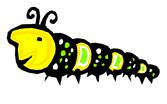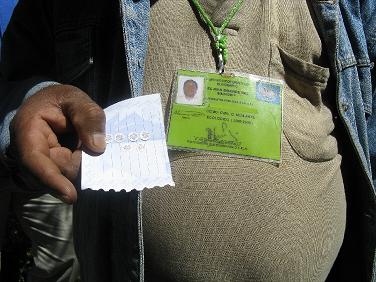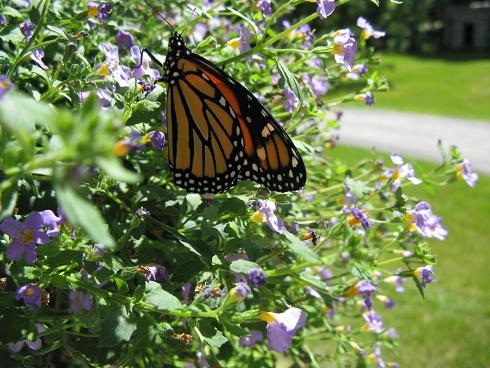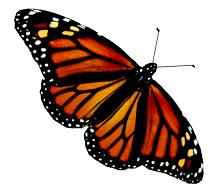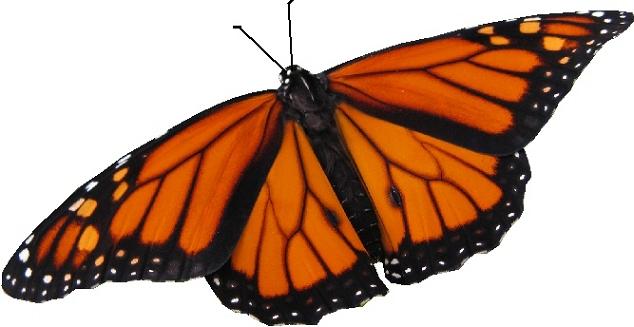C
One of the most beloved of all butterflies also has a most amazing story. Each fall, millions upon millions of these beautiful insects take flight on a trek that will take them thousands of miles to the overwintering grounds of their ancestors. They have never been there before yet they will still find their way to one of the only dozen or so sanctuaries in the high mountains of Mexico. There the Monarchs will roost high in the Oyamel Fir trees awaiting the arrival of spring when they will return to the southern states of the US to lay their eggs on tender new shoots of milkweed. Having completed their task, their lives will end but the new generation of butterflies will in turn continue north, always seeking milkweed, to repeat the process until finally their grandchildren will take that
long journey south for the winter.
THE AMAZING MONARCH BUTTERFLY
DID YOU KNOW? The Monarch Butterfly is the furthest migrating insect in North America!
Have you planted YOUR milkweed, yet? }i{
Click for a larger image
OUR HEAD START PROGRAM
Life in the milkweed patch is tough! In fact, between diseases, predators, pesticides, and habitat destruction, only about one percent of wild monarch eggs that are laid will reach adulthood. By taking eggs and caterpillars into a controlled, sterile environment and raising them we have about a 75% survival rate.
Once collected, eggs are gently sterilized. Caterpillars which hatch from these eggs will be free from disease and protected from predators. Collected caterpillars, if not already host to wasp and fly larvae, can be protected from predation. They can not, however, be salvaged if they are already infected with disease. Caterpillars that hatch from the sterilized eggs and the collected caterpillars are kept separated so that any diseased caterpillars can not infect sterile ones. All are fed a fresh diet of disinfected milkweed until they become chrysalids. Emerged butterflies are kept for one day, then tagged, recorded and released.
 | ||||
 | ||||
Some Monarch Butterfly Facts You Might Like to Know!
- Female Monarchs have thicker wing veins
- The larvae feed on Milkweed leaves for about two weeks and develop into caterpillars about 2 inches long
- Monarch females can lay three to four hundred eggs, usually laying a single egg on a plant. The eggs hatch about three days after they are laid
- The Monarch Butterfly eats milkweed as a caterpillar and eats nectar as an adult butterfly
- It is believed the Monarch Butterfly uses the magnetic field of the earth to migrate. They also depend on the position of the sun as well
- The chemicals from the milkweed plant that the caterpillars eat build up inside them and give them a poisonous defense against predators
- The male Monarchs have a black spot on each of the hind wing over a vein
- The Monarch Butterfly is found through North and South America wherever the milkweed plant grows
- While migrating, a Monarch Butterfly can cover 80 miles a day
- Summer generations of butterflies only live a few weeks. The fall generation can live up to 7 or 8 months
 | ||||
WHY TAG?
Monarch Butterflies from the home of Pollination Station take just over a month to reach their wintering grounds in Mexico. They begin their arrival in Mexico during November and set up winter colonies in only a handful of protected sanctuaries.
To help track this wonderful journey Pollination Station, through the University of Kansas' "Monarch Watch," head started, tagged and released 800 Monarch Butterflies in 2009.
Tagging involves affixing to a wing of each butterfly a uniquely numbered tag. Sex of the butterfly along with its new number, release location and date are recorded and forwarded to the Monarch Watch Team. The tag in no way interferes with flight and accounts for only 1% of a butterfly's weight.
Each March, Monarch Watch team members travel to Mexico to recover tags that have been found on dead butterflies which failed to overwinter. Researchers use this data to determine the status of the overall Monarch population as well as to establish migration routes and timing. Approximatly 100,000 butterflies are tagged each year with a recovery rate of between 1 and 3%.
It's easy to identify male and female Monarch Butterflies once you know what to look for! The males have a pheromone patch located on the lower wing (marked by the white box) and the females tend to have thicker black veins.
 | ||||
MONARCHS & MILKWEED
HUMMINGBIRDS
JUST FOR FUN
SPONSORSHIP PROGRAMS
POLLINATION STATION
POLLINATION
IN THE MEADOW
